PARING DOWN PEARS
So Much From Which to Choose
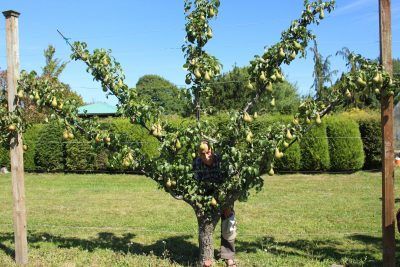
Pear espalier in Mt. Vernon, WA
Of all the common tree fruits, pears are the easiest to grow — and not just here in New York’s Hudson Valley. My site is admittedly poor for tree fruits, the flat lowland acting like a reservoir into which cold, damp air flows, leading to increased threats from diseases and late frosts. Proximity to acres and acres of forest provides haven for insect pests.
But I’m not complaining; the air might be bad for apples, peaches, cherries, plums, and apricots, but underfoot is rich, well-drained, rock-free river bottom soil that grows very nice vegetables, berries, and many uncommon fruits such as persimmons, cornelian cherries, and kiwifruits. And pears.
Of the more than 3,000 varieties of pears, only a handful are well-known. I figured, as with apples, there must be many varieties better or as good-tasting as the few usually offered in markets. Back in 2004, twenty dwarf apple trees that I’d planted were nearing the end of their productive life. So I dug them out, which left me with space for a number of dwarf or semi-dwarf pear trees. But what varieties to plant? I sought suggestions from other fruit growers, from nursery websites and catalogues (especially Raintree Nursery and Cummins Nursery), from the USDA Pear Germplasm Repository, and books such as the 100-year-old tome The Pears of New York, finally settling on sixteen varieties (listed at the end of this blog post to avoid boring you if you don’t want such detail).
The mostly obscure varieties were not available as trees, especially on the rootstocks I wanted. (Particular rootstocks influence the eventual size of the tree as well as how long before it bears its first fruit, and the roots’ resistance to pests and soil challenges.) So I made trees! After ordering scion wood (stems) of the desired varieties and desired rootstock, I set about grafting the trees, which is relatively easy with pears.
Over the years, I did a Henry the Eighth on any trees that didn’t perform well as far as productivity or flavor. In contrast to Henry’s work, I could graft a new variety atop any decapitated trunk and it would grow just fine. In the seventeen years since that initial planting, seven additional varieties found their home here (also listed at the end of this post).
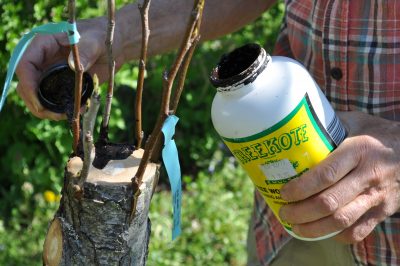
Re-grafting (topworking) pear tree
Paring and Grafting
Back in 1870, Charles Dudley Warner wrote (in My Summer in a Garden), “I have seen gardens which were all experiment, given over to every new thing, and which produced little or nothing to the owners, except the pleasure of expectation.” I did get to sink my teeth into some great-tasting pears over the last seventeen years, so my “experiment” did provide pleasure beyond expectation, but not enough for that number of trees.
So I’m paring down my collection this spring, and making new trees. (Every time I write about making trees I think of the last line of Joyce Kilmer’s poem “Trees” — “But only God can make a tree” — and then am reminded of Woody Allen’s coda “probably because it’s so hard to figure out how to get the bark on.”) I’m selecting what I consider the best of the best varieties, which are . . . (drum roll) . . .
•Magness: In my own opinion and that of many other pear growers, there are few varieties as good as Magness but none better.
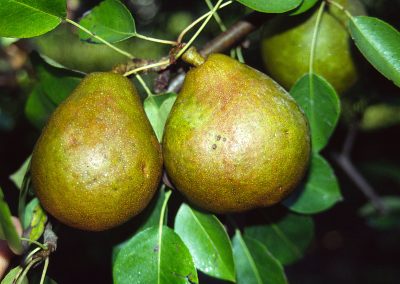
Magness pear
•Warren: Warren, is about the same as Magness in all respects, understandable since they came from the same seedlot.
•Seckel: Although a small pear, Seckel is a definite keeper for its good productivity and, most especially, for its spicy flavor.
•Harrow Delight: This one may not be the best tasting pear, but it’s very good. What I like about it is that comes into bearing age quickly, it bears reliably, and it’s an early season pear, ripening in August.
•Concorde: Very popular on the other side of the Atlantic, Concorde is notable for it vanilla-toned flavor.
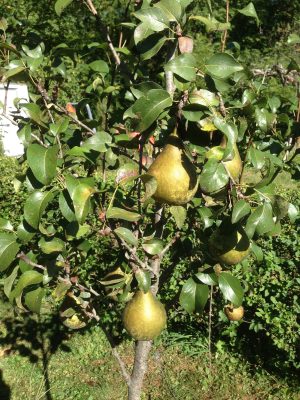
Concorde pear
•Passe Crassane: Here’s a pear that can — that must — be enjoyed from January or February on, not sooner.
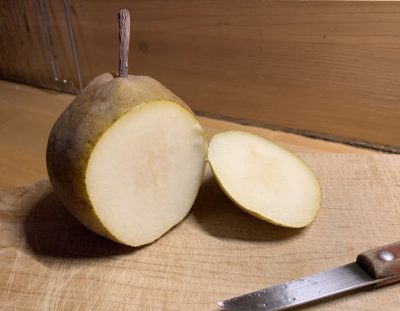
Passe Crassane pear
The jury is still out on the varieties Gourmet and Luscious. I’ll pay close attention to them for the next couple of years.
I’ll be grafting new trees of all of these varieties on a relatively new pear rootstock, Pyrodwarf (P2-33), which promotes early production and maintains dwarf tree height, although reports are conflicting on the degree of dwarfness offered.
Transpacific Gems
Over the years, I’ve also grown a few varieties of Asian pears, which are different species (Pyrus pyrifolia, P. ussuriensis, and Pyrus × bretschneideri ) from the aforementioned European pear varieties (P. communis). The fruits of Asian pears differ markedly from those of European pears, being round, and sweet with mild floral aromas. They have a “cracking” texture, their juice exploding in your mouth with each bite. I’m going to pare down my Asian pears to the varieties Chojuro, Korean Giant (Olympia), and Seuri.
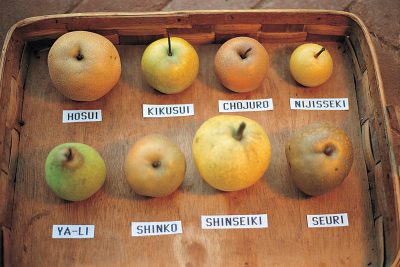
Some Asian pear varieties
Asian pear varieties are very quick to yield their first fruits. They’re also very productive. So productive that I won’t graft them on a rootstock that promotes bearing too soon, which by stealing energy that could otherwise be directed to stem growth, stunts them.
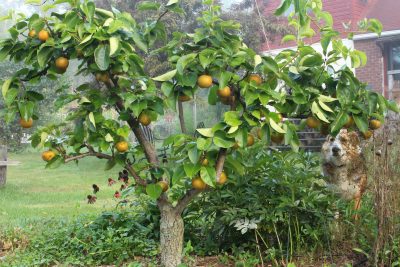
Dwarf Chojuro tree
Both Asian pears and European pears are easy to grow. With European pears, judging when to harvest the fruits is the biggest challenge. With Asian pears it’s removing enough young fruits to leave each a few inches from its neighbor, the sacrifice allowing remaining fruits to be pumped up with better flavor.
Original Variety List: Pear varieties planted in 2004: Beurré Griffard, Blanquet Précoce, Doyenne de Juillet, Duchesse d’Angouleme, Frederick Clapp, Harrow Delight, Highland, Magness, Maxine, Morettini, Seckel, Triomphe de Vienne, Tyson, Vermont Beauty, Tsu Li, Yoinashi
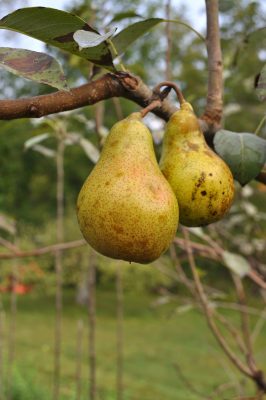
Vermont Beauty
Subsequently added varieties: Warren, Patten, Passe Crassane, Beurée Superfin, Concorde, Gourmet, and Luscious, Ya Li



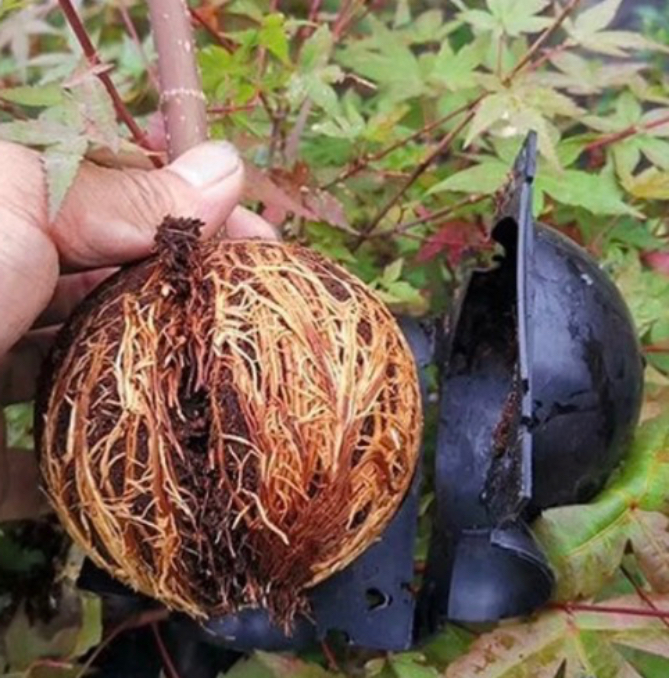
I’m wondering if you note a difference between varieties regarding cooking vs eating out of hand. I grew up with a pear tree that had rather hard fruits to eat but my mom made the best pies with them. I’ve always wanted to plant something similar my garden.
I can’t comment on their cooked quality because I’ve never cooked a pear. In fact, I’m really bad at cooking any fruit. Years ago I attempted to make a gooseberry jam; for some reason it looked pretty repulsive and didn’t taste very good. Muddy purplish.
Have you tried Moon Glow? Just curious mine came yesterday from TY and it’s 9ft. & healthy. Was wondering if this very large start was blessing or misfortune lol. I’m 7b.
I’ve never tasted Moonglow but from what I’ve read, it was released in 1960 along with Magness, both bred for fireblight resistance. Flavor of Magness is among the best; Moonglow is billed as “very good.”
Where to find small (< 10) amounts of Pyrodwarf (P2-33) rootstock?
I don’t know. I got mine by ordering a Bartlett tree grafted on Pyrodwarf. I cut it way back and collected scions of the rootstock. I use these Pyrodwarf scions at interstems for other varieties, withh various rootstocks (seedling, OH x F 87, etc.).
I’m so impressed by your collection. Would you be able to sell scion? (next spring of course)
Perhaps. Contact me next winter, a better time to collect scions.
I just planted Ayers (European) and Shinko (Asian) because both have high fireblight resistance. I have two questions;
1 Do you think I will have pollination problems? These are the only pears around.
2 How does your Shinko rate for flavor and sweetness with the other Asians?
You likely will have pollination problems because European pears bloom later than Asian ones. If Ayers is a late bloomer and Shinko is an early bloomer, they might pollinate.
I haven’t tasted Shinto.